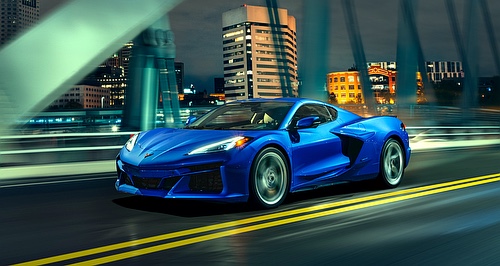News - Chevrolet - Corvette - E-RayFire risk prompts Corvette E-Ray track banPotential lithium-ion battery fires lead to Corvette Club motorsport ban for new E-Ray28 Apr 2023 TROUBLE is brewing in the US regarding the track-ability of Chevy’s new C8 Corvette E-Ray hybrid electric vehicle, the quickest production Corvette in history and allegedly, freshly banned from competing in events sanctioned by the National Council of Corvette Clubs.
According to US reports, the council has an issue with lithium-ion batteries that have developed something of a reputation for spontaneous combustion under certain circumstances – including here in Australia, to the point where legislation is under consideration in some Australian states.
According to US publication TheDrive, reporting posts from CorvetteForum, the Corvette E-Ray, which is capable of accelerating from 0-100km/h in 2.6 seconds, has created consternation in Corvette-land with officials acting on its (non) acceptability at motorsport events and implementing an “official” ban on the new 2024 Chevy Corvette E-Ray competing at Corvette Club events.
Not only that, but the council is also allegedly making the E-Ray something of a pariah by forcing owners to park at least 10 metres away from other cars and buildings if driven to an event… according to the association’s rules.
The problem for Corvette Club officials is the E-Ray’s 1.9-kWh lithium-ion battery pack used to power an integrated electric traction motor that Corvette Club event organisers have deemed “too risky” to have on the track and near anything else because of fire potential.
At this point, the National Council of Corvette Clubs hasn’t issued a formal confirmation of the ban.
According to TheDrive, the rule in question appears to have been added in November 2022, after the car was largely confirmed but before its debut.
“The rule,1.8.1 Item 14 is clear: Electric Vehicles/Hybrids using lithium type battery packs are prohibited in competitive events. If driven to NCCC events, they should be parked 30 feet (10 metres) minimum from structures or other vehicles.”
The NCCC oversees hundreds of autocross (low- and high-speed events) and time trials nationwide, says TheDrive.
The restriction is likely due to the threat that lithium-ion battery packs can pose when they overheat and ignite. Most track managers haven’t yet created a new way to treat battery fires, opting instead to let the batteries largely burn themselves out and mitigate any risks around it.
Adding fuel to the flames is the knowledge that on-track fires involving internal combustion vehicles can stop races for hours, depending on severity. Even off the track, in the pits or car park, fires can stop races as responders are drawn away from their primary task.
It is a risk that is already being reviewed by Australia’s peak motorsport body, Motorsport Australia (formerly CAMS).
Speaking to GoAuto this week, Motorsport Australia CEO, Eugene Arocca, said the body will continue to monitor evolving vehicle technologies to ensure the safety of participants, spectators and crew.
“Motorsport Australia will continue to monitor and analyse the suitability for electric vehicles (EVs) at Australian motorsport events,” he said.
“Safety is always our priority and currently, EVs are permitted at club track day events. We have established rules and criteria for production EVs and if the Corvette E-Ray meets those conditions, and organisers meet ours for EVs at their event, then there is no reason why we would not allow it."
Tests show even small lithium-ion battery fires can take hours to burn out and the packs can remain hot for long after.
However, in response to the problem and given the broad adoption of lithium-ion batteries in many new BEVs, newly developed extinguishers can rapidly cool and contain lithium-ion fires but aren’t yet widely used and are much more expensive compared to regular extinguishers.
The muscle-bound Corvette holds the mantle as “America’s sports car” thanks to its styling, sound, feel and athleticism on the road along with a proven record on the racetrack. Many Corvette owners love nothing more than taking their pride and joy to the track for a good, regular flogging, then drive home.
The E-Ray combines Chevrolet’s 6.2-litre LT2 small block V8 – developing 370kW at 6450rpm and 637Nm at 5150rpm – to drive rear axle via an eight-speed dual-clutch transmission, with electric propulsion adding 119kW and 170Nm to the front wheels.
Total system power is rated at 488kW with battery energy sourced from a tunnel-mounted 1.9kWh lithium-ion unit.
Customer response to the E-Ray has been massive in the US with thousands of Corvette fans willing to plonk down more than $US100,000 ($A150,000) for the new model especially with its expected performance capability… and many would expect to take it to the track a line-ball prospect at the moment.  Read more30th of January 2023  Corvette Z06 brings thunder Down UnderFirst factory right-hook Corvette Z06 lands in Melbourne ahead of customer deliveries26th of January 2023  GM invests $1.3b in future V8 enginesFour GM V8 engine production facilities across the US to get big funding boost |
Click to shareChevrolet articlesResearch Chevrolet Motor industry news |
















Facebook Twitter Instagram